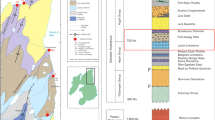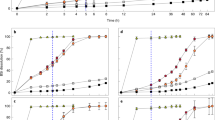Abstract
ONE measure of transport rates and residence times of organic carbon within the various organic carbon pools in the ocean is to follow perturbations from the 1952–58 and 1961–62 atmospheric thermonuclear bomb tests on the natural 14C activities of living, detrital and dissolved organic matter. We report here our measurement of the 14C activity of the total sedimentary organic carbon (SOC) in an abyssal red clay, as no such data were available for this organic carbon pool. Ultimately, these sedimentary organic 14C activities may be compared with the 14C activity of the source organic material in the water column and estimates made of the magnitude of organic carbon consumption at the seawater–sediment interface. What was found, unexpectedly, was evidence for the penetration of recent organic carbon from the 4 cm mixed layer at the sediment–seawater interface down to at least 12 cm in the sedimentary column. This suggests a different and more rapid mechanism for the sedimentation of some fraction of the SOC other than direct association with clay minerals.
This is a preview of subscription content, access via your institution
Access options
Subscribe to this journal
Receive 51 print issues and online access
$199.00 per year
only $3.90 per issue
Buy this article
- Purchase on Springer Link
- Instant access to full article PDF
Prices may be subject to local taxes which are calculated during checkout
Similar content being viewed by others
References
Williams, P. M., Oeschger, H. & Kinney, P. J. Nature 224, 256–258 (1969).
Williams, P. M., McGowan, J. A. & Stuiver, M. Nature 227, 375–376 (1970).
Arhelger, M. E., Kinney, P. J., Linick, T. W. & Williams, P. M. Research on the Marine Food Chain, AEC Progress Report, 363–389 (University of California, San Diego, 1974).
Williams, P. M. & Linick, T. W. in Isotope Ratios as Pollutant Source and Behavior Indicators (IAEA-FAO, Vienna, 1974).
Hessler, R. R. & Jumars, P. A. Deep-Sea Res. 21, 185–209 (1974).
Broecker, W. S. & Olson, E. A. Radiocarbon 3, 176–204 (1961).
Goldberg, E. & Koide, M. Geochim. cosmochim. Acta 26, 417–450 (1962).
Koide, M., Griffin, J. J. & Goldberg, E. D. J. geophys. Res. 80, 4153–4162 (1975).
Nozaki, Y., Cochran, J. K., Turekian, K. K. & Keller, G. Earth planet. Sci. Lett. 34, 167–173 (1977).
Higgo, J J. W., Cheery, R. D., Heyrand, M. & Fowler, S. W. Nature 266, 623–624 (1977).
Donahue, J. Mar. Geol. 11, M1–M7 (1971).
Clarke, R. H. Deep-Sea Res. 15, 397–400 (1968).
Noshkin, V. E., Wong, K. M., Jokela, T. A., Eagle, R. J. & Brunk, J. L. Radionuclides in the Marine Environment near the Farallon Islands (Univ. Calif. Livermore Lab. Report UCRL-52381, 1978).
Hartmann, M., Kögler, F.-C., Müller, P. & Suess, E. in Ütersuchungenzur Genese von Manganknollen (Unveröff. Jahresber, für 1973, Kiel, 1974).
Bowen, V. T., Livingston, H. D. & Burke, J. C. in Transuranium Nuclides in the Environment (IAEA, Vienna, 1976).
Author information
Authors and Affiliations
Rights and permissions
About this article
Cite this article
WILLIAMS, P., STENHOUSE, M., DRUFFEL, E. et al. Organic 14C activity in an abyssal marine sediment. Nature 276, 698–701 (1978). https://doi.org/10.1038/276698a0
Received:
Accepted:
Issue Date:
DOI: https://doi.org/10.1038/276698a0
This article is cited by
-
Estimates of degradable organic carbon in deep-sea surface sediments from 14C concentrations
Nature (1987)
-
Variations in the global content of organic carbon in the oceanic and land biota
Il Nuovo Cimento C (1987)
-
Seasonal fluctuations in deep-sea sediment community oxygen consumption: central and eastern North Pacific
Nature (1984)
-
The possible global budget of carbon dioxide
Il Nuovo Cimento C (1982)
-
Deep-ocean hydrothermal vent communities
Nature (1981)
Comments
By submitting a comment you agree to abide by our Terms and Community Guidelines. If you find something abusive or that does not comply with our terms or guidelines please flag it as inappropriate.



